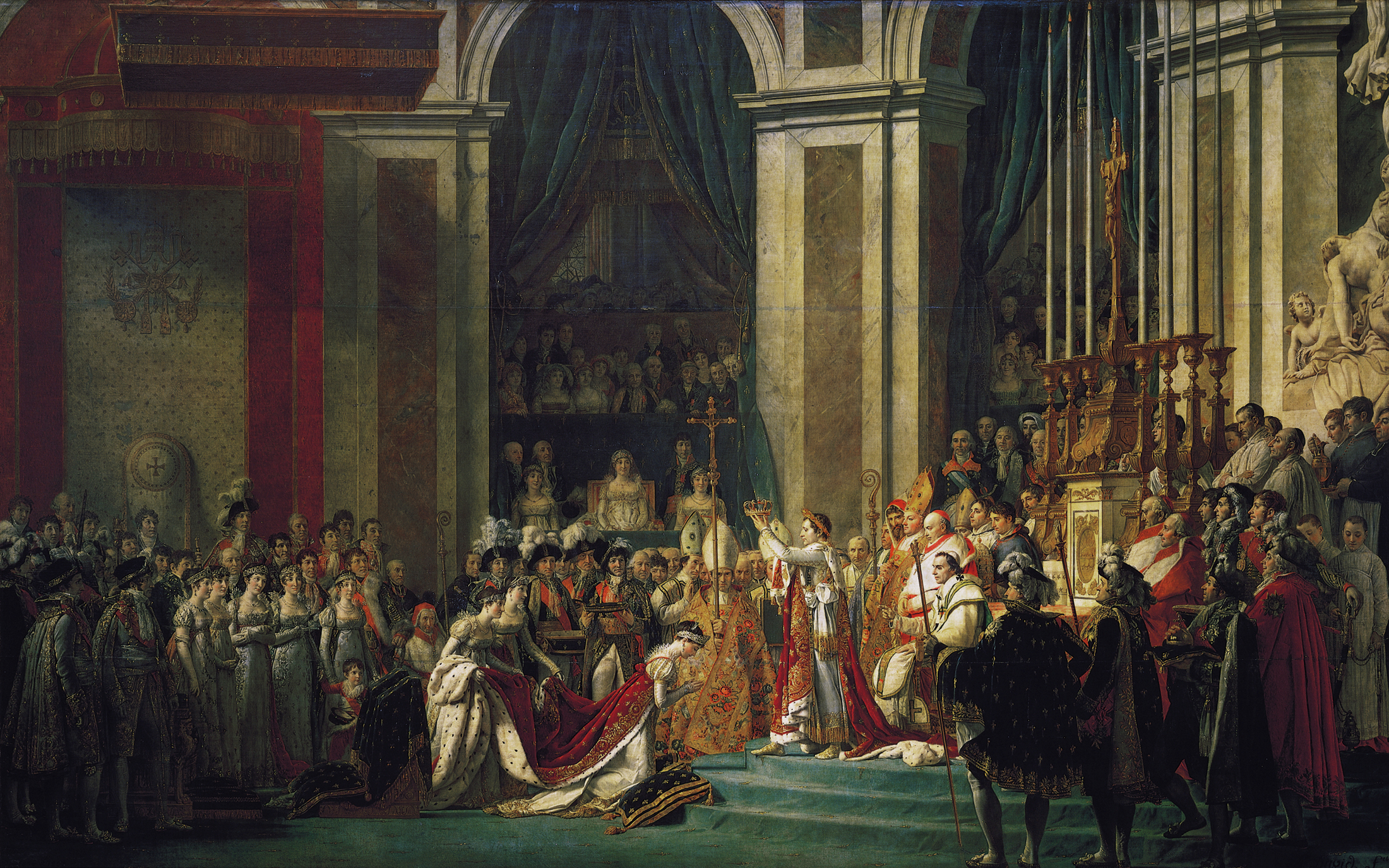Background:
In 1805, Napoleon, Emperor of the French, was facing the Third Coalition- an alliance led by Great Britain, Austria, and Russia. After the disastrous defeat at Trafalgar earlier in the year, Napoleon knew that an invasion of Britain was now impossible, and he made the correct decision to deal with his Continental enemies- the Austrians and Russians.
 |
| The Coronation of Napoleon |
The Campaign:
In addition to his mastery of battlefield tactics, Napoleon was also a masterful military organizer who revolutionized the way units were put together, moved, and supplied themselves. He was the innovator of the corps system. Each corps would be under the command of one of his senior officers, and each would be responsible for its own line of march and supply. This allowed his armies to march longer, farther, and more efficiently than their opponents. There are many who say that winning a battle is not a matter of tactics, but of organizing for it, and Napoleon was preeminent in this art during his storied career. The Austerlitz Campaign is perhaps the best example.
Napoleon crossed the Rhine on September 25th. This was already very late in the season to begin a campaign, and Napoleon's intention was to crush his enemies before they could concentrate their forces.
His opponent in the initial stages was the Austrian general Karl Mack, who marched his forces into Bavaria without waiting for the Russians to arrive and reinforce him. This is precisely what Napoleon wanted. The Austrian concentrated his forces around the town of Ulm, which Napoleon made his primary objective.
This is where the brilliance of the corps system showed itself. Napoleon directed each one toward Ulm, closing the noose around Mack's neck. Mack was compelled to surrender, taking a sizable force out of commission that could now no longer be utilized against the French when the decisive moment arrived.
 |
| Napoleon takes the surrender of Mack |
It was at this point that Napoleon needed to consider the possibility of Prussian intervention. He skilfully conducted a non-aggression pact over the tomb of Frederick the Great to nullify this possibility. The adept diplomacy did not stop there. The Holy Roman Emperor, Francis II, offered an armistice to Napoleon. The French Emperor had nothing to gain from a cessation of hostilities at this point, and so offered terms that were deliberately punitive: Austria to abandon Tyrol and Venice and the retreat of the Russians to Poland. These terms were, as Napoleon planned, rejected.
Though he only had 35,000 men, the Russian commander, Mikhail Kutuzov, crossed the Danube and drove back a French detachment. Napoleon responded to the defeat in stride and seized Vienna, which had been abandoned.
Napoleon still intended to destroy Kutuzov's force before it could link up with any others, but one of his underlings, Marshal Joachim Murat, negotiated an armistice wherein the Russians would leave Germany. A furious Napoleon ordered his subordinate to attack, but this was indecisive, and the Russo-Austrian forces gathered strength. The two forces would meet near Austerlitz.
The Battle:
Napoleon's position was strong, but that of his Russian and Austrian enemies was not. Their columns were isolated.
Phase I:
A Coalition attack toward the French right was repulsed. The offensive was centered toward the French stationed in the village of Telnitz, and with reinforcements by Marshal Davout, the situation was stabilized.
Phase II:
Napoleon had in fact deliberately kept his right weak, so that he could attack in strength toward his primary objective. When he saw that his enemy's center was weakened, the French Emperor ordered an attack toward the area known as Pratzen Heights, which was the lynchpin of the Russo-Austrian line.
A cavalry charge into the Russo-Austrian line nearly killed the Russian Grand Duke Constantine and destroyed the cavalry brigade of General Liechtenstein of the Austrians.
 |
| French Cuirassiers |
Phase III:
Now the finishing touches were administered by Napoleon. The IV Corps under Marshal Soult marched toward the French right and made a flank and rear attack on the enemy. Now that they were pressed everywhere, the Russo-Austrians were forced to retreat in confusion.
Aftermath:
Peace was arranged with the Treaty of Pressburg, ending the War of the Third Coalition. France was now the preeminent power in Germany, eclipsing the Austrians. Francis II would in the next year renounce the ancient title of Holy Roman Empire, at last dissolving the anachronistic entity that had lasted for a millennium. Napoleon would consolidate the former Imperial territories and principalities into the much more compact Confederation of the Rhine to serve as a buffer between France and its principal Continental enemies- Prussia, Austria, and Russia.
 |
| The Holy Roman Empire in 1789 |
 |
| Its replacement, the Confederation of the Rhine, at maximum in 1812 (by ziegelbrenner) |
Assessment:
The political consequences of this battle- the dissolution and replacement of the old Holy Roman Empire, were monumental. Though Napoleon would go down to defeat in the end, the victors of the Napoleonic Wars opted to keep his idea of a German league (the German Confederation) and did not attempt to restore the Holy Roman Empire. The several hundred polities that composed the old entity were thus reduced to around forty, with Austria and Prussia the preeminent figures in the organization.
The first major step toward German unification had thus at last taken place. Prussia and Austria (and later on, France) would go on to decide the fate of the new Germany in the latter half of the century.
 |
| The German Confederation after the Napoleonic Wars |
Edward Cust, Annals of the Wars of the Nineteenth Century, (London: John Murray, Albemarle Street, 1863)
Reginald George Burton, From Boulogne to Austerlitz, Napoleon’s Campaign of 1805, (London: George Allen & Company, LTD, 1912)
Walter Scott, The Life of Napoleon, (Philadelphia: E.L. Carey and A. Hart, 1839) Battle of Austerlitz 1805 Napoleon Bonaparte

No comments:
Post a Comment